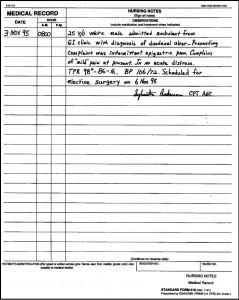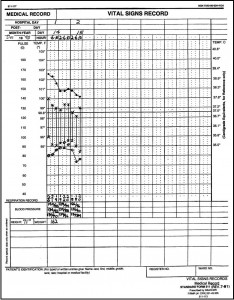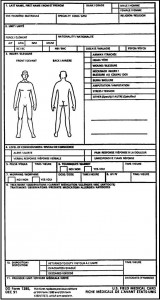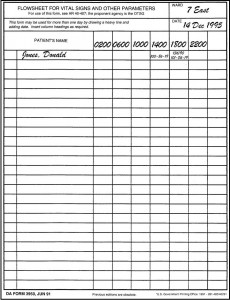At one time, paper forms were used extensively. Currently, electronic medical records have largely replaced paper forms.
Some of the forms on which vital signs are recorded are discussed below.
a. SF 510.
Standard Form 510, Nursing Notes, is used to record the patient’s vital signs and other information when he first enters the hospital. Other entries pertaining to the nursing care provided are made throughout the patient’s hospitalization. Only registered nurses and approved personnel make entries on this form and all entries are made in ink. An example of a SF 510 with an initial (admitting) entry is shown in figure 6-1.

b. SF 511.
While the patient is in the hospital, his vital signs are recorded on Standard Form 511, Vital Signs Record. Entries on this form are made in ink. Only authorized medical personnel make entries on this form. An example of a SF 511 is shown in figure 6-2. Because of the graphic section on the form, the form is also known as the “TPR graphic.”

c. SF 600.
Standard Form 600, Chronological Record of Medical Care, is used to record medical care that the person receives on an outpatient (not in hospital) basis. A common place where entries are made on a SF 600 is the troop medical clinic (TMC). Entries on this form are made in ink. Only authorized personnel make entries on this form. An example of a SF 600 is shown in figure 6-3.
d. DD Form 1380.
Department of Defense Form 1380, US Field Medical Card, is shown in figure 6-4. This card is carried by combat medics in the field. When a soldier is injured, the medic who treats the soldier records information on the card. The soldier’s name and unit, the type of injury, the cause of injury, the treatment given to the patient, and the patient’s vital signs before being evacuated are some of the information entered on the card.
The card is then attached to the injured soldier’s clothing by looping the wire at the end of the card through a buttonhole on the soldier’s uniform. Additional treatment provided during evacuation is also entered on the card by the person who gives the care. The information on the Field Medical Card is transferred at the appropriate time to another form. The Field Medical Card then becomes a part of the soldier’s permanent medical records.
Note: This card is also used by North Atlantic Treaty Organization, NATO– troops. Therefore, the section titles are given in both English and French.

e. DA Form 3950.
The four previous forms become part of the patient’s permanent medical records. The first three are filled out neatly in ink. The Department of Army Form 3950, Flowsheet for Vital Signs and Other Parameters (see figure 6-5) is different. It is a worksheet you can use to record a patient’s vital signs as you take them. You or someone else can then neatly transfer the information to a permanent form (usually the SF 511) later. When all of the information has been transferred, the DA Form 3950 can be destroyed.
NOTE: Your local SOP may require that the DA Form 3950 be kept for a certain length of time before being destroyed in case some of the information transferred to the SF 511 needs to be verified.


